April is the cruelest month…”
– T. S. Eliot
Market Thoughts
The year opened with an upward spike in stock prices. Increased purchases of domestic stock mutual funds signal the return of the individual investor. Yet investors remain skittish; one bad economic statistic and the stock market drops sharply. The catalog of stock market threats is well known: the European sovereign debt crisis; North Korea’s saber rattling, a Chinese hard economic landing, anemic growth in the US, etc. Despite “solving the Cyprus crisis”, most of Europe faces recession and repeated waves of fear about the crisis contagion spreading to Slovenia and beyond. European politicians will continue to paper over the underlying problems before they eventually solve them. But the euro zone is unlikely to break up.
Though with diminished volatility from 2012 levels, the US stock market is back to reactive trading buffeted by the favorability (or lack thereof) of economic reports. Investors feel the pain of losses more intensely than the pleasure of gains. In 2012, investors pulled money from US equity mutual funds for the fifth straight year despite the stock market nearly doubling since March 2009. Yet, continued mistrust of stocks ensures a proverbial “wall of worry” that stock prices climb in a bull market. Stocks are poised for a generational bull market; it may have started but anticipate bumps and reverses along the way.
In an effort to navigate the challenging equity markets, we emphasize sectors like: consumer staples (Church & Dwight, Kellogg, Smucker’s); manufacturers (Deere, General Electric, ITW, Wabtec); medical equipment makers and pharmaceuticals (Bristol Myers, Covidien, Johnson & Johnson, Pfizer); entertainment (Comcast, Disney, Liberty Global, Time Warner); selected technology (Qualcomm, Xylem); insurance (Alleghany, Allied World, White Mountain Insurance); and, dividend plays like Digital Realty (data centers) and Kinder Morgan (energy pipelines).
Economic Perspective
The long industrial decline in the United States might be in reverse. In March manufacturing expanded for the forty-fourth consecutive month. Manufacturing’s share of U. S. GDP has ended a forty year decline, recording its biggest gain in fifty years in 2012. Familiar names like Caterpillar, Ford and NCR are moving some operations back to the United States. Even Apple is building a small manufacturing facility domestically.
Three trends are fuelling the manufacturing resurgence. First, the cost advantages of outsourcing factory work are narrowing with foreign wage levels rising. Second, a weakening of the dollar makes U. S. goods more attractive abroad. And, third, booming domestic energy production, especially of cheap natural gas, helps U. S. steel fabricators, transportation equipment and machinery manufacturers, and petrochemicals. (Natural gas is a feedstock for many chemicals.)
Further bolstering domestic economic growth is a revival in the housing market and improving consumer sentiment. Through large monthly bond purchases and historically low interest rates, the Federal Reserve will continue to nurture these nascent trends.
Privacy Policy Notice
Bache Capital Management, an independent investment advisory firm, is committed to safeguarding the confidential information of its clients. We hold all personal information provided to our firm in the strictest confidence. These records include all personal information that we collect from you or receive from other firms in connection with any of the financial services provided by Bache Capital Management. We also require other firms with whom we deal to restrict the use of your information. A complete privacy statement concerning our firm’s policy is available upon request. If you did not receive and return a confirmation of this policy, please contact us.
Proxy Voting Policy
Another reminder, with the exception of time sensitive reorganization transactions like mergers and acquisitions, the firm does not vote proxies on behalf of clients.
 Stephen K. Bache, CFA
Stephen K. Bache, CFA
Sources: BloombergBusinessweek, The Economist, New York Times, The Wall Street Journal, The New Yorker; Alan Blinder, After The Music Stopped